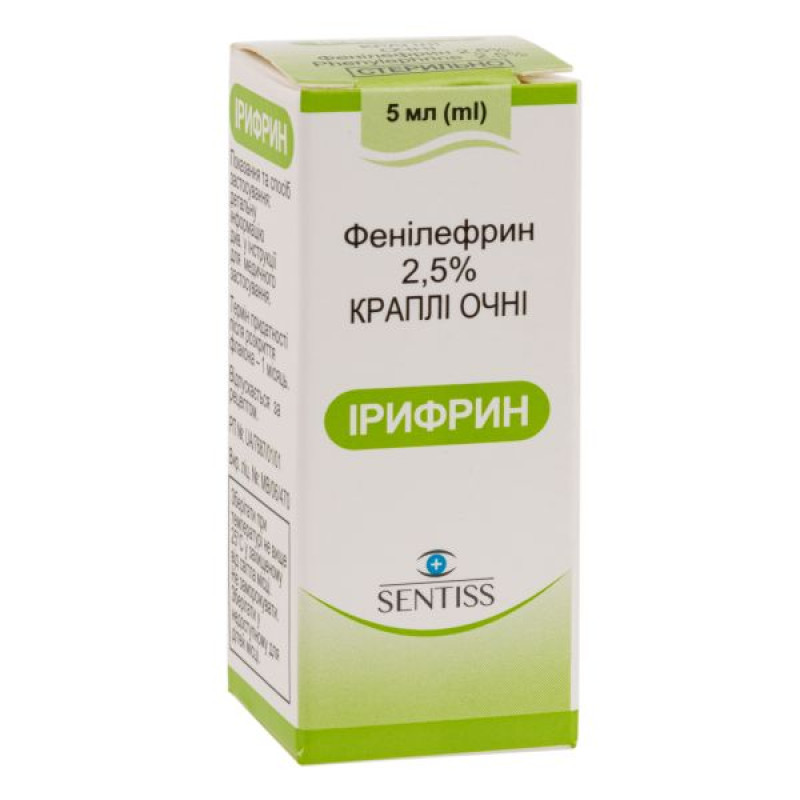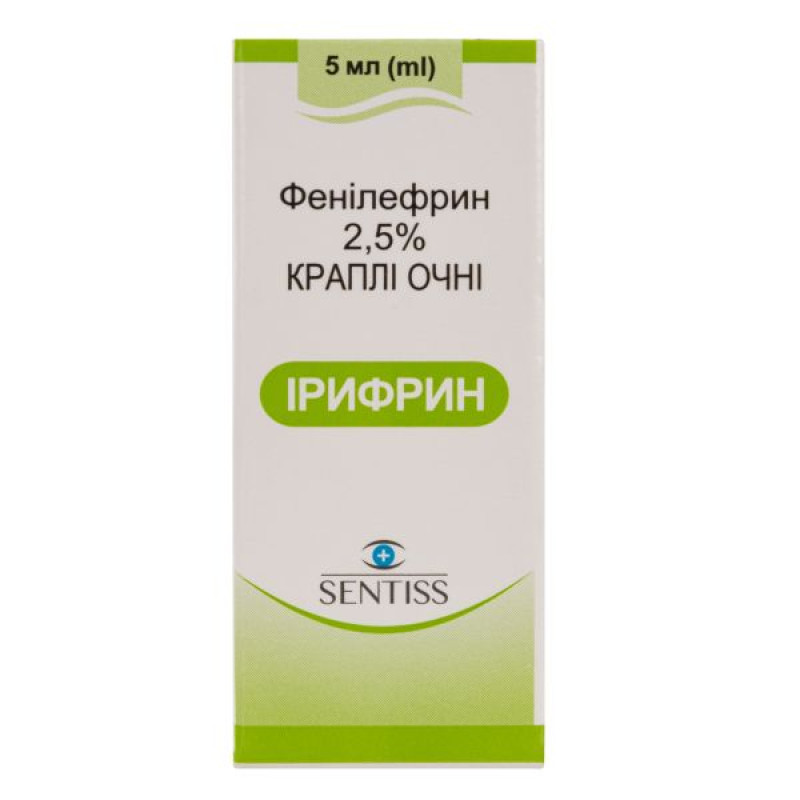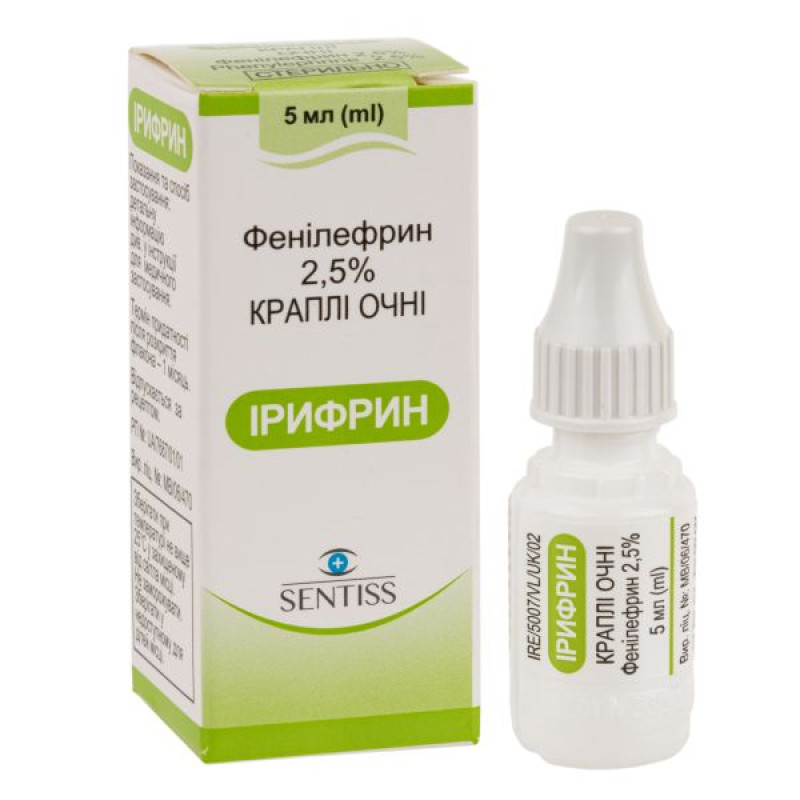Irifrin eye drops 2.5% dropper bottle 5 ml

Instructions for Irifrin eye drops 2.5% dropper bottle 5 ml
Composition
active ingredient: phenylephrine;
1 ml of the drug contains phenylephrine hydrochloride 25 mg;
Excipients: benzalkonium chloride, disodium edetate, hypromellose, sodium metabisulfite (E 223), sodium citrate, anhydrous citric acid, water for injections.
Dosage form
Eye drops.
main physicochemical properties: clear, colorless solution or slightly yellow liquid.
Pharmacotherapeutic group
Drugs used in ophthalmology. Mydriatic and cycloplegic drugs. ATX code S01F B01.
Pharmacological properties
Pharmacodynamics
The drug has a pronounced stimulating effect on postsynaptic alpha-adrenergic receptors, while the effect on beta-adrenergic receptors of the heart is almost not expressed. The drug exhibits a vasoconstrictor effect similar to that of norepinephrine, but it has practically no chronotropic and inotropic effect on the heart. The vasopressor effect of the drug is less pronounced than that of norepinephrine, but much longer. When used in usual doses, it does not exhibit a significant stimulating effect on the central nervous system. After instillation, phenylephrine contracts the pupil dilator, thereby causing its expansion, and the smooth muscles of the conjunctival arterioles. There is no effect on the ciliary muscle, so mydriasis occurs without cycloplegia.
Pharmacokinetics
Phenylephrine easily penetrates the eye tissue, pupil dilation occurs within 10-60 minutes after a single instillation. Mydriasis persists for 4-6 hours. Due to a significant reduction in the pupil dilator, particles of pigment from the pigment sheet of the iris may be detected in the anterior chamber fluid 30-45 minutes after instillation. This phenomenon must be distinguished from manifestations of anterior uveitis or from the presence of blood cells in the anterior chamber fluid.
Indication
Iridocyclitis, anterior uveitis (for the purpose of treatment and prevention of posterior synechiae and reduction of exudation from the iris).
Diagnostic pupil dilation during ophthalmoscopy and other diagnostic procedures necessary to determine the condition of the posterior segment of the eye.
Performing a provocation test in patients with a narrow anterior chamber angle profile and suspected angle-closure glaucoma.
Differential diagnosis of eyeball injection type.
Pupil dilation during laser interventions on the fundus and vitreoretinal surgery.
Red eye syndrome (to reduce hyperemia and irritation of the eye membranes).
Complex therapy of accommodation spasm in school-age children.
Treatment and prevention of asthenopia.
Contraindication
Hypersensitivity to any component of the drug.
Narrow-angle or angle-closure glaucoma.
Significant disorders of the cardiovascular system (heart disease, hypertension, aneurysm, tachycardia), especially in elderly patients.
Insulin-dependent diabetes mellitus.
Thyrotoxicosis.
Hyperthyroidism.
Concomitant use with monoamine oxidase inhibitors (MAOIs) and use within 2 weeks after discontinuation of MAOI treatment.
Additional pupil dilation during surgery in patients with impaired eyeball integrity or impaired tear secretion.
Concomitant use with tricyclic antidepressants, antihypertensive drugs (including beta-blockers).
Congenital deficiency of glucose-6-phosphate dehydrogenase.
Hepatic porphyria.
Contraindicated in newborns with low body weight.
Contraindicated in newborns and infants with cardio- or cerebrovascular disorders.
Contraindicated in elderly patients with severe arteriosclerotic, cardiovascular or cerebrovascular diseases.
Interaction with other medicinal products and other types of interactions
The mydriatic effect of phenylephrine is enhanced by topical atropine and attenuated by topical application of other ophthalmic preparations containing miotics. The drug may inhibit the ability of miotics to reduce intraocular pressure.
The mydriatic effect of phenylephrine is enhanced by topical application of atropine.
Antihypertensive drugs (including beta-blockers) are contraindicated for use simultaneously with phenylephrine for topical use, as the occurrence of arterial hypertension or the reverse effect of antihypertensive drugs with fatal consequences is possible.
MAO inhibitors. The simultaneous use of phenylephrine with monoamine oxidase inhibitors and use within 2 weeks after discontinuation of treatment with MAO inhibitors is contraindicated. The use of phenylephrine within 21 days after discontinuation of MAO inhibitors should be carried out with caution, since the development of systemic adrenergic effects is possible.
Inhalation anesthesia. The drug may potentiate cardiovascular depression during inhalation anesthesia. Due to the increased risk of ventricular fibrillation, the drug should be used with caution during general anesthesia with anesthetics such as halothane (fluorothane), which cause increased myocardial sensitivity to sympathomimetics.
Cardiac glycosides or quinidine: Increased risk of arrhythmia.
Application features
Phenylephrine hydrochloride is a drug that has an adrenergic effect and is used in ophthalmology mainly to achieve a mydriatic effect. The drug has a slight effect on the ciliary muscle of the eye, so there is no significant effect on accommodation, although the dilation of the pupil may reduce the depth of field and cause deterioration of vision.
Systemic exposure can be minimized by pressing the inner corner of the eye with a finger for 1 minute after instilling the drops (this blocks the passage of the drops through the nasolacrimal canal to the nasal and pharynx mucosa, especially recommended for infants, children and the elderly).
Since the effect of pupil dilation may last for 1-3 hours, patients may experience photophobia, so until vision is fully restored, it is necessary to protect the eye(s) from bright sunlight, including the use of sunglasses. It is necessary to exclude visual strain (reading, watching TV, etc.) until the disappearance of residual manifestations of mydriasis.
In case of conjunctival hyperemia and damage to the corneal epithelium, increased absorption and increased undesirable systemic effects are possible.
In order to avoid exacerbation of glaucoma, it is necessary to assess the anterior chamber angle before using the drug. To prevent unpleasant sensations when using phenylephrine, you can apply drops with an anesthetic a few minutes before instillation.
Elderly patients. Reactive miosis may occur. Reactive miosis was observed in elderly patients a day after the use of phenylephrine solution, and repeated application led to a decrease in pupil dilation. Use with caution in patients with cerebral atherosclerosis, cardiovascular diseases, chronic bronchial asthma, arterial hypertension or insulin-controlled diabetes. Due to the pronounced effect of the drug on dilation, temporary appearance of floating pigment spots in the intraocular fluid in elderly patients within 30-45 minutes after instillation of phenylephrine solution into the eye.
Children. The lowest dose necessary to obtain the desired effect should always be used. Parents should be advised to avoid getting the product in the child's mouth or on the cheeks and to wash their hands and the child's hands and cheeks after administration. Children in general, and especially low birth weight and premature infants, are at increased risk of systemic adverse reactions, including a transient increase in blood pressure, which increases the risk of intraventricular hemorrhage. The infant should be monitored after instillation and adequate rescue measures should be taken if necessary.
Contact lenses. Since the drug contains the preservative benzalkonium chloride, it may cause irritation and discoloration of soft contact lenses. Therefore, the patient should remove contact lenses before use and wait 15 minutes after instillation of the drug before using contact lenses again.
Ability to influence reaction speed when driving vehicles or other mechanisms
Before driving a car or operating machinery, you must wait until your vision has fully recovered.
Use during pregnancy or breastfeeding
Not studied. Use is possible if the expected benefit to the mother outweighs the risk to the fetus or child. Breastfeeding should be discontinued during treatment with the drug.
Method of administration and doses
When performing ophthalmoscopy, use a single instillation of 2.5% solution. As a rule, to achieve mydriasis, it is enough to instill 1 drop of 2.5% solution of the drug into the conjunctival sac. Maximum mydriasis is achieved after 15-30 minutes and remains at a sufficient level for 1-3 hours. If mydriasis needs to be maintained for a long time, repeated instillation is possible after 1 hour.
For diagnostic procedures, a single instillation of a 2.5% solution is used:
In iridocyclitis, anterior uveitis, the drug is used to treat and prevent the development of posterior synechiae; to reduce exudation into the anterior chamber of the eye. For this purpose, 1 drop of the drug is instilled into the conjunctival sac of the affected eye(s) 2-3 times a day.
Complex therapy of accommodation spasm and asthenopia in school-age children.
For mild myopia, prescribe 1 drop of a 2.5% solution of the drug before bedtime on days of high visual load, for moderate myopia - 1 drop of a 2.5% solution 3 times a week before bedtime, and in the case of emmetropia (absence of myopia) - daily, regardless of visual load.
For patients with hyperopia who have a tendency to spasm, use a 2.5% solution of the drug in combination with 1 drop of 1% cyclopentolate before bedtime during periods of high visual load, and during normal times use 3 times a week.
Use in elderly patients. No dose adjustment is necessary for elderly patients. Repeated instillations may produce less pronounced mydriasis.
Before the first use, screw the cap all the way in, turning it from left to right. The scarifier contained in the cap will pierce the bottle spout. After that, you can open the bottle as usual, turning the cap to the left. When performing instillations, it is necessary to follow sanitary and hygienic rules, wash your hands with soap, do not touch the dropper spout with your fingers.
Children
In pediatric practice, for diagnostic procedures (ophthalmoscopy, retinography), the drug can be used in children from the first days of life. Use in premature infants is possible with caution after a doctor assesses the risk-benefit ratio: no more than 1 drop in each eye.
Overdose
Even with topical application, manifestations of systemic action of phenylephrine are possible. Most often, this is a significant increase in blood pressure, reflex bradycardia.
Treatment: use of alpha-blockers. In case of reflex bradycardia, atropine should be used (in children - at a dose of 0.01-0.02 mg/kg of body weight).
Adverse reactions
Immune system disorders: hypersensitivity, allergic conjunctivitis.
On the part of the organs of vision: eye pain, in some cases burning sensation (at the beginning of use), reactive hyperemia, blurred vision, eye irritation, discomfort, photophobia, lacrimation, increased intraocular pressure in patients with narrow-angle or angle-closure glaucoma, reactive miosis (the next day after use; repeated instillations may produce less pronounced mydriasis than the day before; the effect is more common in elderly patients). In premature newborns, periorbital pallor is possible.
Cardiovascular system: tachycardia, cardiac arrhythmias, including ventricular, arterial hypertension, reflex bradycardia, coronary artery occlusion, pulmonary embolism, myocardial infarction.
Reporting of suspected adverse reactions. After a medicinal product has been authorised, reporting of suspected adverse reactions is an important procedure. This allows monitoring of the benefit/risk balance of the medicinal product. Healthcare professionals can report all suspected adverse reactions via the national reporting system.
Patients, in case of undesirable manifestations, adverse reactions or in case of lack of therapeutic effect, can inform the Contact Person of the company "Sentiss Pharma Private Limited", India in Ukraine by phone +38 044 585-04-60 or by e-mail: info@regata.in.ua.
Expiration date
2 years.
The shelf life after opening the bottle is 1 month.
Do not use after the expiration date indicated on the package.
Storage conditions
Store at a temperature not exceeding 25 °C, protected from light. Do not freeze.
Keep out of reach of children.
Packaging
5 ml in a dropper bottle with a scarifier cap, 1 bottle per pack.
Vacation category
According to the recipe.
Producer
SENTISS PHARMA PVT. LTD
Location of the manufacturer and its business address
Village Khera Nihla, Tehsil Nalagarh, Distt. Solan, Himachal Pradesh, 174 101, India.
There are no reviews for this product.
There are no reviews for this product, be the first to leave your review.
No questions about this product, be the first and ask your question.








